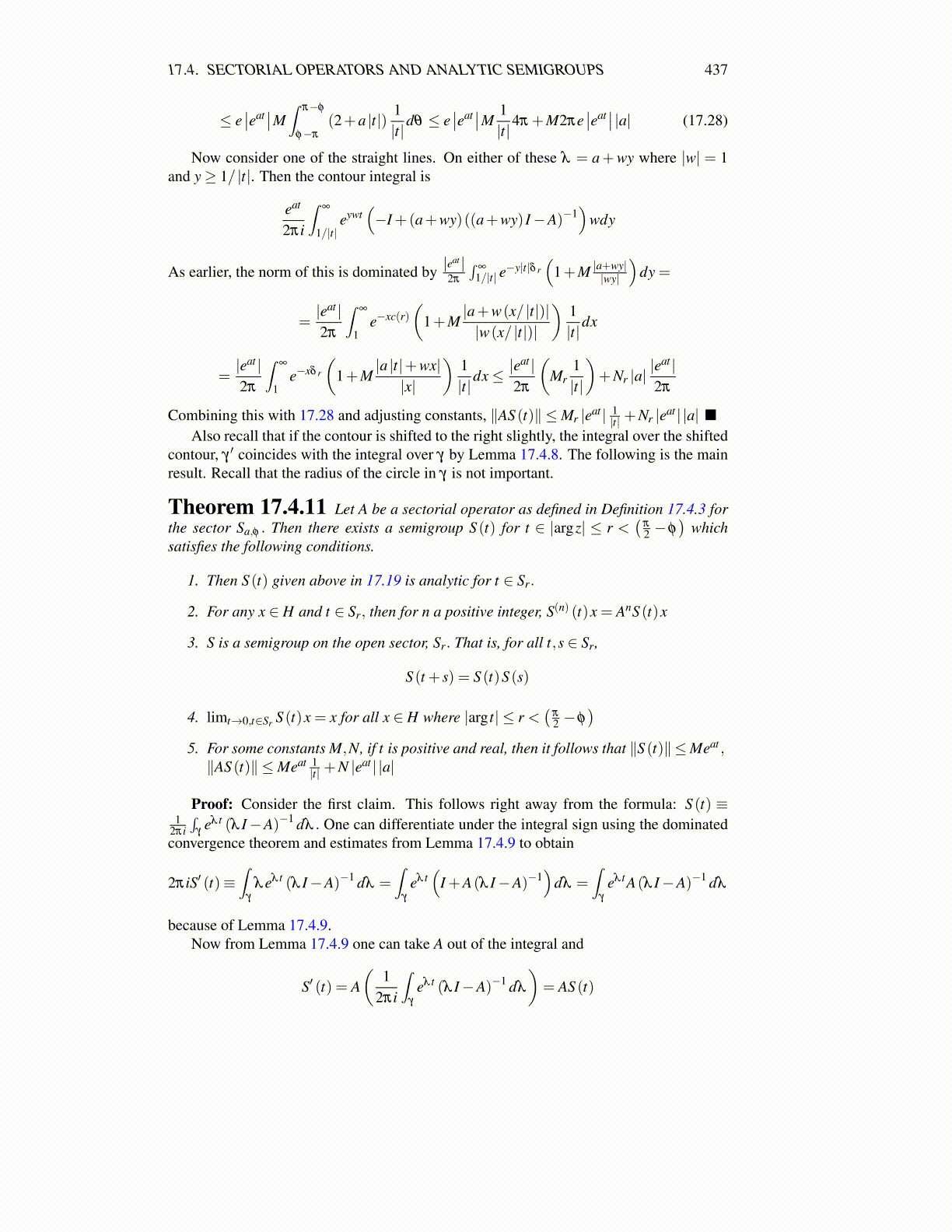
17.4. SECTORIAL OPERATORS AND ANALYTIC SEMIGROUPS 437
≤ e∣∣eat ∣∣M ∫
π−φ
φ−π
(2+a |t|) 1|t|
dθ ≤ e∣∣eat ∣∣M 1
|t|4π +M2πe
∣∣eat ∣∣ |a| (17.28)
Now consider one of the straight lines. On either of these λ = a+wy where |w| = 1and y≥ 1/ |t|. Then the contour integral is
eat
2πi
∫∞
1/|t|eywt
(−I +(a+wy)((a+wy) I−A)−1
)wdy
As earlier, the norm of this is dominated by |eat |
2π
∫∞
1/|t| e−y|t|δ r
(1+M |a+wy|
|wy|
)dy =
=|eat |2π
∫∞
1e−xc(r)
(1+M
|a+w(x/ |t|)||w(x/ |t|)|
)1|t|
dx
=|eat |2π
∫∞
1e−xδ r
(1+M
|a |t|+wx||x|
)1|t|
dx≤ |eat |
2π
(Mr
1|t|
)+Nr |a|
|eat |2π
Combining this with 17.28 and adjusting constants, ∥AS (t)∥ ≤Mr |eat | 1|t| +Nr |eat | |a| ■
Also recall that if the contour is shifted to the right slightly, the integral over the shiftedcontour, γ ′ coincides with the integral over γ by Lemma 17.4.8. The following is the mainresult. Recall that the radius of the circle in γ is not important.
Theorem 17.4.11 Let A be a sectorial operator as defined in Definition 17.4.3 forthe sector Sa,φ . Then there exists a semigroup S (t) for t ∈ |argz| ≤ r <
(π
2 −φ)
whichsatisfies the following conditions.
1. Then S (t) given above in 17.19 is analytic for t ∈ Sr.
2. For any x ∈ H and t ∈ Sr, then for n a positive integer, S(n) (t)x = AnS (t)x
3. S is a semigroup on the open sector, Sr. That is, for all t,s ∈ Sr,
S (t + s) = S (t)S (s)
4. limt→0,t∈Sr S (t)x = x for all x ∈ H where |arg t| ≤ r <(
π
2 −φ)
5. For some constants M,N, if t is positive and real, then it follows that ∥S (t)∥ ≤Meat ,∥AS (t)∥ ≤Meat 1
|t| +N |eat | |a|
Proof: Consider the first claim. This follows right away from the formula: S (t) ≡1
2πi∫
γeλ t (λ I−A)−1 dλ . One can differentiate under the integral sign using the dominated
convergence theorem and estimates from Lemma 17.4.9 to obtain
2πiS′ (t)≡∫
γ
λeλ t (λ I−A)−1 dλ =∫
γ
eλ t(
I +A(λ I−A)−1)
dλ =∫
γ
eλ tA(λ I−A)−1 dλ
because of Lemma 17.4.9.Now from Lemma 17.4.9 one can take A out of the integral and
S′ (t) = A(
12πi
∫γ
eλ t (λ I−A)−1 dλ
)= AS (t)